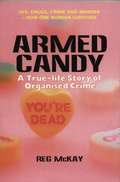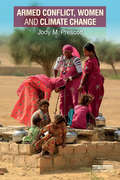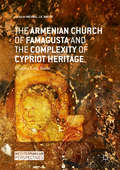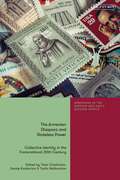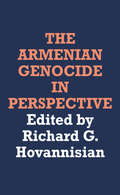- Table View
- List View
Armed and Considered Dangerous: A Survey of Felons and Their Firearms (Social Institutions And Social Change Ser.)
by Peter H. RossiArmed and Considered Dangerous is a book about "bad guys" and their guns. But Wright and Rossi contend that for every suspected criminal who owns and abuses a firearm, a hundred or more average citizens own guns for sport, for recreation, for self-protection, and for other reasons generally regarded as appropriate or legitimate. Armed and Considered Dangerous is the most ambitious survey ever undertaken of criminal acquisition, possession, and use of guns.There are vast differences between the average gun owner and the average gun-abusing felon, but the analyses reported here do not suggest any obvious way to translate these differences into gun control policies. Most policy implications drawn from the book are negative in character: this will not work for this reason, that will not work for that reason, and so on. When experts are asked, "Okay, then what will work?" they usually fall back on the old warhorses of poverty, the drug problem, or the inadequate resources of the criminal justice system, and otherwise have little to say. This is not a failure of social science. It simply asks more of the data than the data were ever intended to provide.Several of Wright and Rossi's findings have become "coin of the realm" in the gun control debate, cited frequently by persons who have long since forgotten where the data came from or what their limitations are. Several other findings, including many that are important, have been largely ignored. Still other findings have been superseded by better and more recent data or rendered anachronistic by intervening events. With the inclusion of a new introduction detailing recent statistics and updated information this new edition of Armed and Considered Dangerous is a rich source of information for all interested in learning about weapon behavior and ownership in America.
Armed Candy: A True-Life Story of Organised Crime
by Reg McKayArmed Candy is the true story of one woman's struggle for survival on Britain's meanest streets. Kay has spent her whole life trying to escape. Sexually abused by her grandmother, she pleaded to return to her mother's care. But instead of finding a safe haven, Kay entered a world of drug abuse, swinging and dabbling in the occult. Although still a small child, she was soon buying drugs for her mother and being moved out of her bed as orgies ensued in her home. When she tried to escape, she ended up in a violent marriage, from which she fled in fear of her life. Turning to her mother for help, she was tricked into prostitution, her own mother acting much like a pimp. Kay became a high-class call girl, but then, through a chance meeting, she got involved with the most dangerous criminal gang in Glasgow. Women associated with such gangs are often seen as decorative arm candy, but Kay was admitted to the inner core, where she became involved in making decisions of life and death. She fell in love with the gang's equaliser, a young man feared throughout the country, and together they formed a formidable partnership. But they were too successful, and when they appeared to threaten some powerful interests they had to be taken out. The day that Kay's lover was gunned down in broad daylight saw the beginning of a reign of death in the city, as the organised crime world became paranoid and turned in on itself. For Kay, it was the beginning of her way out.
Armed Conflict and Forcible Displacement: Individual Rights under International Law (Routledge Research in International Law)
by Elena Katselli ProukakiThis book addresses the involuntary and arbitrary displacement of individuals resulting from armed conflict and gross human rights violations. It shows that forcible displacement constitutes a serious violation of international law and of fundamental community interests. Armed Conflict and Forcible Displacement provides a critical legal analysis of the contemporary international framework, permeating forcible displacement in these circumstances and explores the rights that individuals possess with specific focus on the right not to be displaced and, where this fails, the right to return home and to receive property restitution. In doing so, this volume marries together different fields of international law and builds on the case studies of Cyprus, Colombia, Cambodia and Syria. While the case studies considered here are far from exhaustive, they are either little explored or present significant challenges due to the magnitude of displacement or contested international jurisprudence. Through this analysis, the volume exposes some of the legal challenges that individuals encounter in being protected from forcible displacement, as well as the legal obstacles that persist in ensuring the return of and the recovery of property by the displaced. It will be of interest to those interested in the fields of international law, human rights law, as well as conflict and war studies.
Armed Conflict and Forcible Displacement: Individual Rights under International Law (Routledge Research in International Law)
by Elena Katselli ProukakiThis book addresses the involuntary and arbitrary displacement of individuals resulting from armed conflict and gross human rights violations. It shows that forcible displacement constitutes a serious violation of international law and of fundamental community interests. Armed Conflict and Forcible Displacement provides a critical legal analysis of the contemporary international framework, permeating forcible displacement in these circumstances and explores the rights that individuals possess with specific focus on the right not to be displaced and, where this fails, the right to return home and to receive property restitution. In doing so, this volume marries together different fields of international law and builds on the case studies of Cyprus, Colombia, Cambodia and Syria. While the case studies considered here are far from exhaustive, they are either little explored or present significant challenges due to the magnitude of displacement or contested international jurisprudence. Through this analysis, the volume exposes some of the legal challenges that individuals encounter in being protected from forcible displacement, as well as the legal obstacles that persist in ensuring the return of and the recovery of property by the displaced. It will be of interest to those interested in the fields of international law, human rights law, as well as conflict and war studies.
Armed Conflict, Women and Climate Change
by Jody M. PrescottThe gender-differentiated and more severe impacts of armed conflict upon women and girls are well recognised by the international community, as demonstrated by UN Security Council Resolution (UNSCR) 1325 on Women, Peace and Security and subsequent resolutions. Similarly, the development community has identified gender-differentiated impacts upon women and girls as a result of the effects of climate change. Current research and analysis has reached no consensus as to any causal relationship between climate change and armed conflict, but certain studies suggest an indirect linkage between climate change effects such as food insecurity and armed conflict. Little research has been conducted on the possible compounding effects that armed conflict and climate change might have on at-risk population groups such as women and girls. Armed Conflict, Women and Climate Change explores the intersection of these three areas and allows the reader to better understand how military organisations across the world need to be sensitive to these relationships to be most effective in civilian-centric operations in situations of humanitarian relief, peacekeeping and even armed conflict. This book examines strategy and military doctrine from NATO, the UK, US and Australia, and explores key issues such as displacement, food and energy insecurity, and male out-migration as well as current efforts to incorporate gender considerations in military activities and operations. This innovative book will be of great interest to students and scholars of international relations, international development, international security, sustainability, gender studies and law.
Armed Conflict, Women and Climate Change
by Jody M. PrescottThe gender-differentiated and more severe impacts of armed conflict upon women and girls are well recognised by the international community, as demonstrated by UN Security Council Resolution (UNSCR) 1325 on Women, Peace and Security and subsequent resolutions. Similarly, the development community has identified gender-differentiated impacts upon women and girls as a result of the effects of climate change. Current research and analysis has reached no consensus as to any causal relationship between climate change and armed conflict, but certain studies suggest an indirect linkage between climate change effects such as food insecurity and armed conflict. Little research has been conducted on the possible compounding effects that armed conflict and climate change might have on at-risk population groups such as women and girls. Armed Conflict, Women and Climate Change explores the intersection of these three areas and allows the reader to better understand how military organisations across the world need to be sensitive to these relationships to be most effective in civilian-centric operations in situations of humanitarian relief, peacekeeping and even armed conflict. This book examines strategy and military doctrine from NATO, the UK, US and Australia, and explores key issues such as displacement, food and energy insecurity, and male out-migration as well as current efforts to incorporate gender considerations in military activities and operations. This innovative book will be of great interest to students and scholars of international relations, international development, international security, sustainability, gender studies and law.
Armed Conflicts in South Asia 2013: Transitions
by D. Suba Chandran P. R. ChariSeventh in the annual series, this volume focuses on civil society movements in South Asia, besides covering armed conflicts in the region in 2012. The first section addresses the conflicts in Afghanistan, Pakistan and Myanmar, and the situation in Northeast India and Naxalite violence; the second assesses peace audits in Nepal, Sri Lanka, Jammu and Kashmir, along with the peace process in Nagaland.
Armed Conflicts in South Asia 2013: Transitions
by D. Suba Chandran P. R. ChariSeventh in the annual series, this volume focuses on civil society movements in South Asia, besides covering armed conflicts in the region in 2012. The first section addresses the conflicts in Afghanistan, Pakistan and Myanmar, and the situation in Northeast India and Naxalite violence; the second assesses peace audits in Nepal, Sri Lanka, Jammu and Kashmir, along with the peace process in Nagaland.
Armed for Life: The Army of God and Anti-Abortion Terror in the United States (PSI Guides to Terrorists, Insurgents, and Armed Groups)
by Jennifer JefferisThis book provides a detailed and comprehensive look at the primary players, acts, motivations, and methods of the Army of God in their quest to make abortion illegal in the United States.The Army of God may not be widely known, but they are well established as an extremist Christian organization united in their belief that abortion must be stopped at all costs, including the use of violence or force. Who are the primary players in this underground terrorist group, what acts are they responsible for, and what are the motivations behind their quest to make abortion illegal in the United States?Armed for Life: The Army of God and Anti-Abortion Terror in the United States addresses these questions and more, drawing upon never-before-published interviews with members of the Army of God and their own writings to reveal the details of this grossly understudied organization—and to document what its existence and expansion says about our society.
Armed for Life: The Army of God and Anti-Abortion Terror in the United States (PSI Guides to Terrorists, Insurgents, and Armed Groups)
by Jennifer JefferisThis book provides a detailed and comprehensive look at the primary players, acts, motivations, and methods of the Army of God in their quest to make abortion illegal in the United States.The Army of God may not be widely known, but they are well established as an extremist Christian organization united in their belief that abortion must be stopped at all costs, including the use of violence or force. Who are the primary players in this underground terrorist group, what acts are they responsible for, and what are the motivations behind their quest to make abortion illegal in the United States?Armed for Life: The Army of God and Anti-Abortion Terror in the United States addresses these questions and more, drawing upon never-before-published interviews with members of the Army of God and their own writings to reveal the details of this grossly understudied organization—and to document what its existence and expansion says about our society.
The Armed Forces: Towards a Post-Interventionist Era? (Schriftenreihe des Zentrums für Militärgeschichte und Sozialwissenschaften der Bundeswehr #14)
by Gerhard Kümmel Bastian GiegerichThe present anthology stems from the perception of a widespread and manifest uneasiness concerning the business of military intervention in our times. Indeed, the West is for quite some time engaged in a deep introspection about his military intervention policies in the years to come and reflects about this. What will Western military intervention policies look like in the future; what kind of military intervention policies is wanted and what kind of military intervention policies is financially, politically and socio-culturally possible and militarily feasible? The hypothesis pursued in this volume states that, in the foreseeable future, we may see a different kind of military intervention policy and intervention posture of the West that will lead to different military interventions. It may be argued that we are witnessing the dawn of a new era, the era of military post-interventionism.
Armed Robbery
by Roger MatthewsDespite the significance of armed robbery in the criminal justice system, the media and in the public mind there has been little systematic research or writing on the subject beyond the popular accounts. In both the USA and the UK there remains a large gap in the literature on the subject, which this book aims to fill. It provides a comprehensive account of armed robbery, based on extensive research with 350 armed robbers in prison, and on work with two police armed response units Despite the significance of armed robbery in the criminal justice system, the media and in the public mind there has been little systematic research or writing on the subject beyond the popular accounts – from the Metropolitan and South Yorkshire Police. This is the book on the subject.
Armed Robbery
by Roger MatthewsDespite the significance of armed robbery in the criminal justice system, the media and in the public mind there has been little systematic research or writing on the subject beyond the popular accounts. In both the USA and the UK there remains a large gap in the literature on the subject, which this book aims to fill. It provides a comprehensive account of armed robbery, based on extensive research with 350 armed robbers in prison, and on work with two police armed response units Despite the significance of armed robbery in the criminal justice system, the media and in the public mind there has been little systematic research or writing on the subject beyond the popular accounts – from the Metropolitan and South Yorkshire Police. This is the book on the subject.
Armenia and Imperial Decline: The Yerevan Province, 1900-1914 (Routledge Advances in Armenian Studies)
by George BournoutianThis book seeks, for the first time, to examine the demography and the social and economic conditions in the Yerevan Province during the first decade of the twentieth century, before the great changes that occurred during World War I and the seven decades of Soviet rule. Unlike in Tiflis and Baku, the Armenian inhabitants of the Yerevan Province were overwhelmingly peasants. They did not play a major role in the political, intellectual or economic life of the South Caucasus. The aim of the book is to prove conclusively that the Armenians of the Yerevan Province not only benefited from living under the umbrella of imperial security, but, as junior and senior officials, they also acquired important administrative and professional skills. The social and economic changes of the last decade of Russian rule enabled the local Armenians to advance and, following the collapse of the Russian Empire, to occupy posts previously held by Russians. Thus, despite the absence of their most talented individuals and the lack of experienced political leaders, as well as the loss of half their territory to Turkish attacks in 1918, the local Armenian administration, in the face of terrible conditions and great odds, provided the foundation which allowed the Armenian Republic to maintain its independence until December of 1920. In fact, some of the survivors would assist in the modernization and nation building of Soviet Armenia. Providing a detailed overview of the history of the Yerevan Province in the late imperial age, this book will be a valuable resource for students and scholars interested in the History of Armenia, the Russian Empire and the Caucasus.
Armenia and Imperial Decline: The Yerevan Province, 1900-1914 (Routledge Advances in Armenian Studies)
by George BournoutianThis book seeks, for the first time, to examine the demography and the social and economic conditions in the Yerevan Province during the first decade of the twentieth century, before the great changes that occurred during World War I and the seven decades of Soviet rule. Unlike in Tiflis and Baku, the Armenian inhabitants of the Yerevan Province were overwhelmingly peasants. They did not play a major role in the political, intellectual or economic life of the South Caucasus. The aim of the book is to prove conclusively that the Armenians of the Yerevan Province not only benefited from living under the umbrella of imperial security, but, as junior and senior officials, they also acquired important administrative and professional skills. The social and economic changes of the last decade of Russian rule enabled the local Armenians to advance and, following the collapse of the Russian Empire, to occupy posts previously held by Russians. Thus, despite the absence of their most talented individuals and the lack of experienced political leaders, as well as the loss of half their territory to Turkish attacks in 1918, the local Armenian administration, in the face of terrible conditions and great odds, provided the foundation which allowed the Armenian Republic to maintain its independence until December of 1920. In fact, some of the survivors would assist in the modernization and nation building of Soviet Armenia. Providing a detailed overview of the history of the Yerevan Province in the late imperial age, this book will be a valuable resource for students and scholars interested in the History of Armenia, the Russian Empire and the Caucasus.
The Armenian Church of Famagusta and the Complexity of Cypriot Heritage: Prayers Long Silent
by Michael J.K. WalshThis book explores seven centuries of change in Cyprus and the Eastern Mediterranean world through the rise and fall of Famagusta’s medieval Armenian Church. An examination of the complex and its art escorts the reader from the era of the Crusades in Lusignan Cyprus, through the rise and fall of the Venetian, Ottoman and British Empires, to the political stasis of the present day. The Armenian church was a home for displaced villagers during the post-independence era, became a military storage facility post-1974 and eventually fell into abandonment once again. This study represents a pioneering history of the Armenian community in Famagusta and a probing analysis of the art and architecture it left behind. It is also a permanent record of the long-term engagement and commitment of Nanyang Technological University Singapore, the World Monuments Fund, and the Famagusta Municipality to protect this precious site, under extremely challenging circumstances.
The Armenian Church of Famagusta and the Complexity of Cypriot Heritage: Prayers Long Silent
by Michael J.K. WalshThis book explores seven centuries of change in Cyprus and the Eastern Mediterranean world through the rise and fall of Famagusta’s medieval Armenian Church. An examination of the complex and its art escorts the reader from the era of the Crusades in Lusignan Cyprus, through the rise and fall of the Venetian, Ottoman and British Empires, to the political stasis of the present day. The Armenian church was a home for displaced villagers during the post-independence era, became a military storage facility post-1974 and eventually fell into abandonment once again. This study represents a pioneering history of the Armenian community in Famagusta and a probing analysis of the art and architecture it left behind. It is also a permanent record of the long-term engagement and commitment of Nanyang Technological University Singapore, the World Monuments Fund, and the Famagusta Municipality to protect this precious site, under extremely challenging circumstances.
The Armenian Diaspora and Stateless Power: Collective Identity in the Transnational 20th Century (Armenians in the Modern and Early Modern World)
by Talar Chahinian, Sossie Kasbarian and Tsolin NalbantianFrom genocide, forced displacement, and emigration, to the gradual establishment of sedentary and rooted global communities, how has the Armenian diaspora formed and maintained a sense of collective identity? This book explores the richness and magnitude of the Armenian experience through the 20th century to examine how Armenian diaspora elites and their institutions emerged in the post-genocide period and used “stateless power” to compose forms of social discipline. Historians, cultural theorists, literary critics, sociologists, political scientists, and anthropologists explore how national and transnational institutions were built in far-flung sites from Istanbul, Aleppo, Beirut and Jerusalem to Paris, Los Angeles, and the American mid-west. Exploring literary and cultural production as well as the role of religious institutions, the book probes the history and experience of the Armenian diaspora through the long 20th century, from the role of the fin-de-siècle émigré Armenian press to the experience of Syrian-Armenian asylum seekers in the 21st century. It shows that a diaspora's statelessness can not only be evidence of its power, but also how this “stateless power” acts as an alternative and complement to the nation-state.
The Armenian Diaspora and Stateless Power: Collective Identity in the Transnational 20th Century (Armenians in the Modern and Early Modern World)
From genocide, forced displacement, and emigration, to the gradual establishment of sedentary and rooted global communities, how has the Armenian diaspora formed and maintained a sense of collective identity? This book explores the richness and magnitude of the Armenian experience through the 20th century to examine how Armenian diaspora elites and their institutions emerged in the post-genocide period and used “stateless power” to compose forms of social discipline. Historians, cultural theorists, literary critics, sociologists, political scientists, and anthropologists explore how national and transnational institutions were built in far-flung sites from Istanbul, Aleppo, Beirut and Jerusalem to Paris, Los Angeles, and the American mid-west. Exploring literary and cultural production as well as the role of religious institutions, the book probes the history and experience of the Armenian diaspora through the long 20th century, from the role of the fin-de-siècle émigré Armenian press to the experience of Syrian-Armenian asylum seekers in the 21st century. It shows that a diaspora's statelessness can not only be evidence of its power, but also how this “stateless power” acts as an alternative and complement to the nation-state.
The Armenian Genocide: Wartime Radicalization or Premeditated Continuum
by Richard G. HovannisianWorld War I was a watershed, a defining moment, in Armenian history. Its effects were unprecedented in that it resulted in what no other war, invasion, or occupation had achieved in three thousand years of identifiable Armenian existence. This calamity was the physical elimination of the Armenian people and most of the evidence of their ever having lived on the great Armenian Plateau, to which the perpetrator side soon gave the new name of Eastern Anatolia. The bearers of an impressive martial and cultural history, the Armenians had also known repeated trials and tribulations, waves of massacre, captivity, and exile, but even in the darkest of times there had always been enough remaining to revive, rebuild, and go forward.This third volume in a series edited by Richard Hovannisian, the dean of Armenian historians, provides a unique fusion of the history, philosophy, literature, art, music, and educational aspects of the Armenian experience. It further provides a rich storehouse of information on comparative dimensions of the Armenian genocide in relation to the Assyrian, Greek and Jewish situations, and beyond that, paradoxes in American and French policy responses to the Armenian genocides. The volume concludes with a trio of essays concerning fundamental questions of historiography and politics that either make possible or can inhibit reconciliation of ancient truths and righting ancient wrongs.
The Armenian Genocide: Wartime Radicalization or Premeditated Continuum
by Richard G. HovannisianWorld War I was a watershed, a defining moment, in Armenian history. Its effects were unprecedented in that it resulted in what no other war, invasion, or occupation had achieved in three thousand years of identifiable Armenian existence. This calamity was the physical elimination of the Armenian people and most of the evidence of their ever having lived on the great Armenian Plateau, to which the perpetrator side soon gave the new name of Eastern Anatolia. The bearers of an impressive martial and cultural history, the Armenians had also known repeated trials and tribulations, waves of massacre, captivity, and exile, but even in the darkest of times there had always been enough remaining to revive, rebuild, and go forward.This third volume in a series edited by Richard Hovannisian, the dean of Armenian historians, provides a unique fusion of the history, philosophy, literature, art, music, and educational aspects of the Armenian experience. It further provides a rich storehouse of information on comparative dimensions of the Armenian genocide in relation to the Assyrian, Greek and Jewish situations, and beyond that, paradoxes in American and French policy responses to the Armenian genocides. The volume concludes with a trio of essays concerning fundamental questions of historiography and politics that either make possible or can inhibit reconciliation of ancient truths and righting ancient wrongs.
The Armenian Genocide in Perspective
by Stephen R. GraubardSeven decades after the destruction of the Armenian population in the Ottoman Empire, the Armenian genocide remains largely ignored by governments and forgotten by the world public, even though the annihilation of Armenians was headlined around the world in 1915. Scholarly investigation of the Armenian genocide is just beginning, made more difficult by the tendency of many establishment figures to rationalize the past and the attempt of perpetrator governments and their successors to deny the past.This volume is a pioneering collective attempt to assess and analyze the Armenian genocide from differing perspectives, including history, political science, ethics, religion, literature, and psychiatry. Focusing on the general implications of denial, rationalization, and responsibility, it is particularly important as a precursor to the study of the Holocaust and other genocides.
The Armenian Genocide in Perspective
by Richard G. HovannisianSeven decades after the destruction of the Armenian population in the Ottoman Empire, the Armenian genocide remains largely ignored by governments and forgotten by the world public, even though the annihilation of Armenians was headlined around the world in 1915. Scholarly investigation of the Armenian genocide is just beginning, made more difficult by the tendency of many establishment figures to rationalize the past and the attempt of perpetrator governments and their successors to deny the past.This volume is a pioneering collective attempt to assess and analyze the Armenian genocide from differing perspectives, including history, political science, ethics, religion, literature, and psychiatry. Focusing on the general implications of denial, rationalization, and responsibility, it is particularly important as a precursor to the study of the Holocaust and other genocides.
The Armenian Kingdom in Cilicia During the Crusades: The Integration of Cilician Armenians with the Latins, 1080-1393 (Caucasus World)
by Jacob GhazarianThis unique study bridges the history of the Crusades with the history of Armenian nationalism and Christianity. To the Crusaders, Armenian Christians presented the only reliable allies in Anatolia and Asia Minor, and were pivotal in the founding of the Crusader principalities of Edessa, Antioch, Jerusalem and Tripoli. The Anatolian kingdom of Cilicia was founded by the Roupenian dynasty (mid 10th to late 11th century), and grew under the collective rule of the Hetumian dynasty (late 12th to mid 14th century). After confrontations with Byzantium, the Seljuks and the Mongols, the Second Crusade led to the crowning of the first Cilician king despite opposition from Byzantium. Following the Third Crusade, power shifted in Cilicia to the Lusignans of Cyprus (mid to late 14th century), culminating in the final collapse of the kingdom at the hands of the Egyptian Mamluks.
The Armenian Kingdom in Cilicia During the Crusades: The Integration of Cilician Armenians with the Latins, 1080-1393 (Caucasus World)
by Jacob GhazarianThis unique study bridges the history of the Crusades with the history of Armenian nationalism and Christianity. To the Crusaders, Armenian Christians presented the only reliable allies in Anatolia and Asia Minor, and were pivotal in the founding of the Crusader principalities of Edessa, Antioch, Jerusalem and Tripoli. The Anatolian kingdom of Cilicia was founded by the Roupenian dynasty (mid 10th to late 11th century), and grew under the collective rule of the Hetumian dynasty (late 12th to mid 14th century). After confrontations with Byzantium, the Seljuks and the Mongols, the Second Crusade led to the crowning of the first Cilician king despite opposition from Byzantium. Following the Third Crusade, power shifted in Cilicia to the Lusignans of Cyprus (mid to late 14th century), culminating in the final collapse of the kingdom at the hands of the Egyptian Mamluks.

